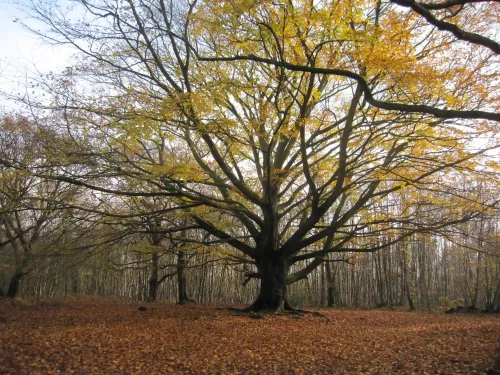
10 must-visit Kent woodlands
Be sure to check out these 10 woods whilst exploring Kent, each offering something a little different across the county.


Common pipistrelle bats - Tom Marshall
Ancient woodlands offer abundant and high-quality roosting opportunities for bats. Cavities and hollows in trees make the perfect roosting spot for several species of bat. Some species, such as the barbastelle and noctule bat, are considered woodland specialists. They make their homes in ancient or old growth woods, behind loose bark or in the cracks of damaged and dead trees.
With different species demanding roosting spots of all shapes and sizes, diverse and mature woodlands boast the variety that boosts bat biodiversity. Noctules - Britain’s largest species of bat - prefer the comfort of woodpecker and rot holes. Solitary male Noctule bats even rely on tree holes during the mating season to attract partners. Upon finding a suitable hole, the male will emit a range of shrill mating calls from the entrance of the roost and during flight, all while releasing a strong odour that is attractive to female noctules. The male will typically stay in their chosen mating roost for several weeks and will defend their roost from competing males. A male noctule bat can attract anywhere up to 20 females during mating season.
Veteran trees are particularly valuable to bats in British woodlands. Having stood the test of time, these mature trees are characterised by hollows, cracks and cavities that have formed over many years of growth and decay. These features provide excellent roosting opportunities for bats. Veteran and ancient trees often provide more stable and long-lasting roosting sites compared to younger trees due to their more established nature and density of attractive features. Some species, like the barbastelle, roost in trees year-round and favour woodlands with many veteran, dead and damaged trees. Droppings and parasites can accumulate in hollows overtime, therefore woodlands with an abundance of old trees allow bats to move flexibly between roosts.
Veteran trees underpin healthy woodland ecosystems, pumping a constant supply of deadwood into the soil that promotes diverse fungi communities. Deadwood also creates damp environments for moss to flourish and provides a vital food source to insects. Mammals and birds alike seek shelter in their canopies and humans reap the benefits of their hefty carbon storage. These ancient giants are one of our greatest wild assets, but if they are not afforded adequate protection, centuries of growth can be lost.
Bats are most active during the warm summer months and can be observed at both sunrise and sunset. They can often be seen flying low over waterways in search of insects, while some fly high in the sky or over grassland and trees. There's no one-size-fits-all approach to spotting Britain's bats!
Those interested observing these mysterious mammals will be pleased to learn that you don't always have to travel far. They can often be seen over streams, lakes, rivers, hedgerows and even your local park. Using a simple piece of equipment called a bat detector, budding bat fanatics can listen to bats as they dart and dive overhead. Bats echolocate at a pitch that is too high for human hearing to pick up. A bat detector uses a microphone to listen to these shrill noises and instead produces a frequency that can be heard with human ears. The device reads the frequency, and observers can reference this number against a field guide to identify the bat species. For example, brown long eared bats are known to produce calls between 25 – 50kHz; these calls are quiet and may be hard to detect, prompting many to refer to the species as 'whispering bats'.
Out of the 18 bat species located in Britain, 14 can be found in Kent. Most can be seen for a couple of hours at sunset and for around an hour at sunrise. Some bats, like the noctule, are early risers and are often the first to be spotted, sometimes even before sunset. Kent’s most familiar bat is the common pipistrelle, closely followed by its cousin, the soprano pipistrelle. Each species of bat echolocates at a different frequency. The common pipistrelle echolocates around 45kHz while the soprano echolocates around 55kHz.
Covert Wood is a 26-hectare area of precious ancient woodland, situated in the Kent Downs Area of Outstanding Natural Beauty in East Kent. Comprised of towering oaks, beech, hornbeam and sweet chestnut, this striking broadleaf woodland has stood tall for centuries. Knotted mature trees, bountiful deadwood and swathes of woodland wildflowers provide the building blocks for insect diversity, ensuring a crucial food supply to birds, mammals, reptiles and amphibians. Sadly, Covert Wood is at risk of being sold piece by piece, making it impossible to manage for the benefit of nature.
Ancient woodlands now cover just 2.5% of Britain's landmass. If we do not protect and defend these age-old woodlands, we will deny future generations the chance to enjoy one of Britain’s most complex and diverse habitats. If ancient woodlands disappear, Britain’s rarest woodland species will follow suit. We have a rare opportunity to purchase a vast area of ancient woodland. With your help, we can help Covert Wood to reach its full potential.

Be sure to check out these 10 woods whilst exploring Kent, each offering something a little different across the county.

Since bison were released into West Blean and Thornden Woods on the outskirts of Canterbury, they have not only transformed the landscape but significantly grown in number.

Natasha Ruskin explores something terrifying: a world without woodlands.